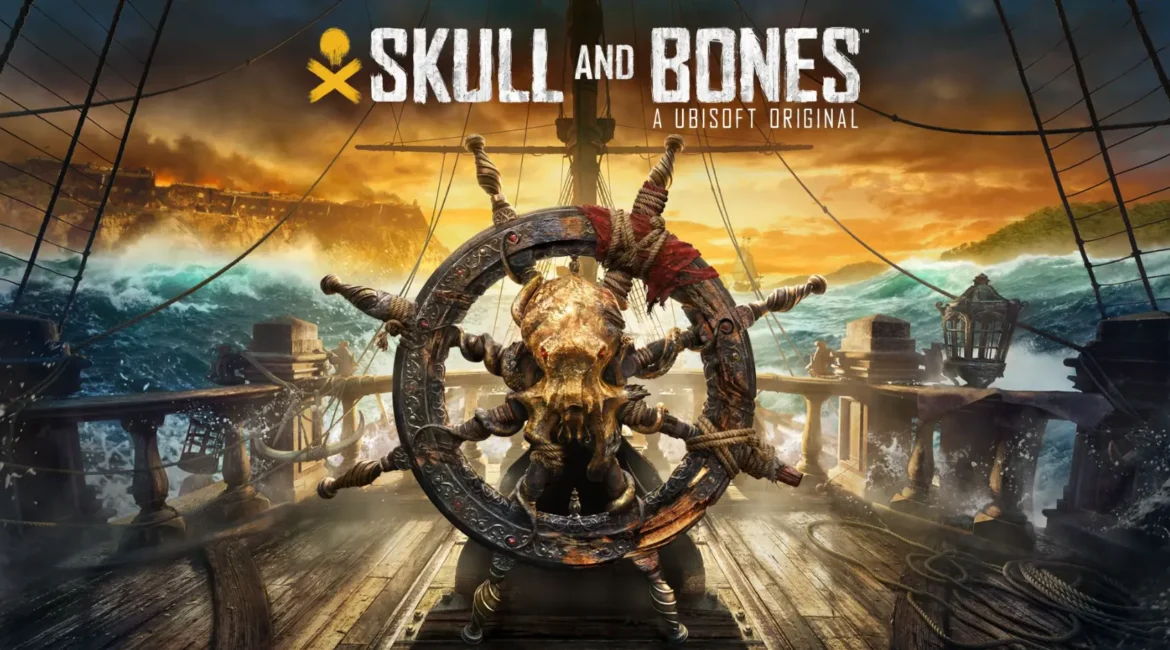Release Date : February 16, 2024
Developer(s) : Ubisoft Singapore
Publisher(s) : Ubisoft
Platforms : PS5, Xbox Series X/S, PC
Ten years in development and six postponements before its release, Skull and Bones is finally ready to set sail. A pirate game that Ubisoft’s CEO recently described as quadruple A and which, due to a production that took far too long to reach “land”, has many people wondering what it’s all about. So, is it worth the trouble? We’ve sailed the seven seas to find out.
After a decade of development, six postponements and even a reboot, Ubisoft Singapore’s huge game will finally see the light of day this February 16, 2024 on PC, PS5, and Xbox Series X|S. We’re eager to find out: what could a title with such a long development period possibly look like? Well, now is the time to find out. Let’s set sail! Here’s our full review of Skull and Bones.
Table of Contents
Loot, Shoot, and Look Good
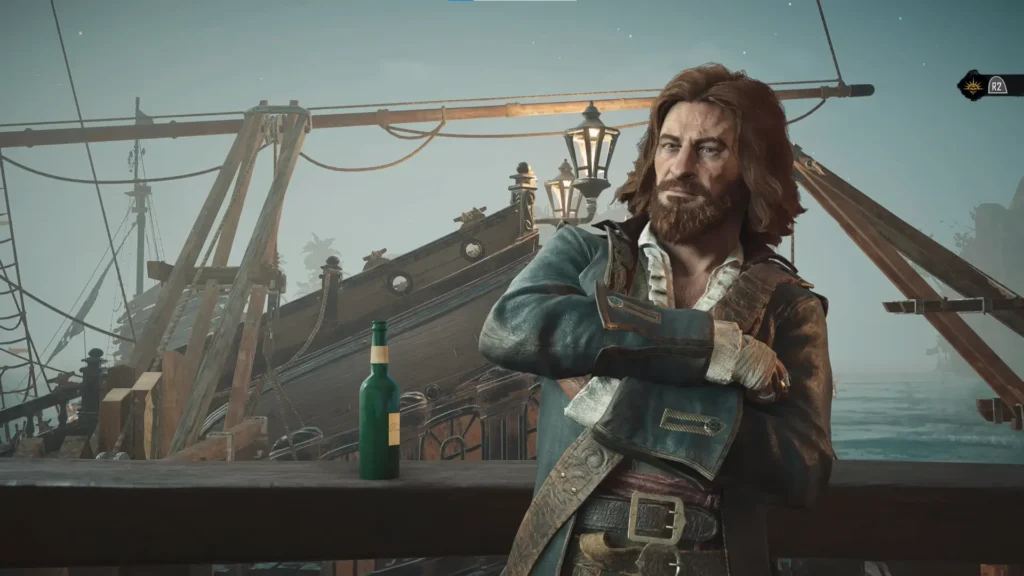
Take off your eye patch and take a deep breath: by the way, what is Skull and Bones? First of all, it’s not some Sea of Thieves clone (the famous pirate game from Rare and Xbox). This is a wet multiplayer experience – Internet connection required – but you’re the only captain on board. In other words, your ship responds to all your commands, and you don’t need three pairs of hands to raise the anchor, hoist the sail, or load the cannons. The same is true if you’re joined by other sailors! Skull and Bones lets you take up to two friends with you, so you can sail the seven seas of the Indian Ocean in a fleet of three.
We’ll talk more about multiplayer later on, but for now, it’s important to remember that Skull and Bones is all about the action on board, so much so that it’s tempting to call it an “online naval battle game” rather than a pirate game. In fact, with the exception of the 2 main cities and some 30 outposts where your hero can stretch his legs (i.e., walk and chat), everything takes place on the water! There are no 3rd-person confrontations, even when you board a ship (a cinematic takes over), nor can you swim. This may be disappointing for some, but once you’ve got over the surprise effect, you’ll get used to it with no problem.
Game Service, My Captain, Game Service!
At this point, we’d like to take this opportunity to remind you that Skull and Bones is a service game, which means it relies heavily on legendary items and cosmetics. There’s plenty to do to customize the appearance of your pirate and your ship. There are also in-game purchases to unlock more skins. To Ubisoft’s credit, the store is discreet, appearing only in the pause menu. What’s more, the items on sale are purely cosmetic and give no power advantage ( not at launch, anyway).
So Many Ports

Another difference with Sea of Thieves is that Skull and Bones is much less of a sandbox, with a good storyline. Here, after a short introduction, you land in the town of Sainte-Anne – a well-known pirate hideout – where you’ll meet John Scurlock, an old sea dog in search of a trusted ally… And so begins your long quest to become a “Kingpin” – which unlocks access to the endgame – and become the king of pirates!
After a few hours: you’re free to go your own way and complete the numerous contracts offered by Skull and Bones. Just bear in mind that the main objectives earn you more experience and (often) better equipment for your ship. On the other hand, don’t expect a breathtaking storyline. Ubisoft’s writing struggles to engage the player, and we quickly find ourselves more interested in the loot than in what they’re trying to tell us. This is also where Skull and Bones’ mechanics come up against the label “pirate game”. Yes, even with the best pretexts in the world (based on betrayals and financial interests), you still end up shooting rafts over and over again. But that doesn’t make it a bad experience.
Because the “little” that Skull and Bones does, it does well. From our point of view, we particularly liked the naval battles, which are both exciting and dynamic… On this point, Ubisoft has reproduced the gameplay of Assassin’s Creed Black Flag for the most part. As in the old days, all you have to do is move the camera and play with the triggers to engage the various weapons – looking at the front of the boat to arm the bow arsenal, for example. It works like a charm, and fits Skull and Bones’ action dimension perfectly!
The physics are heavier and more realistic by comparison with Black Flag, with challenging ship movements and cannonball paths. In combat – aside from the overall power level of your craft – it’s your skill at the helm that makes the difference, and that’s a real pleasure. For example, we’ve sunk ships with two extra levels. The secret? Knowing how to manage your stamina, which allows your ship to “sprint” and activate a super-strong shield, plus precision ( enemy ships have weak points highlighted in red).
Deep Sea
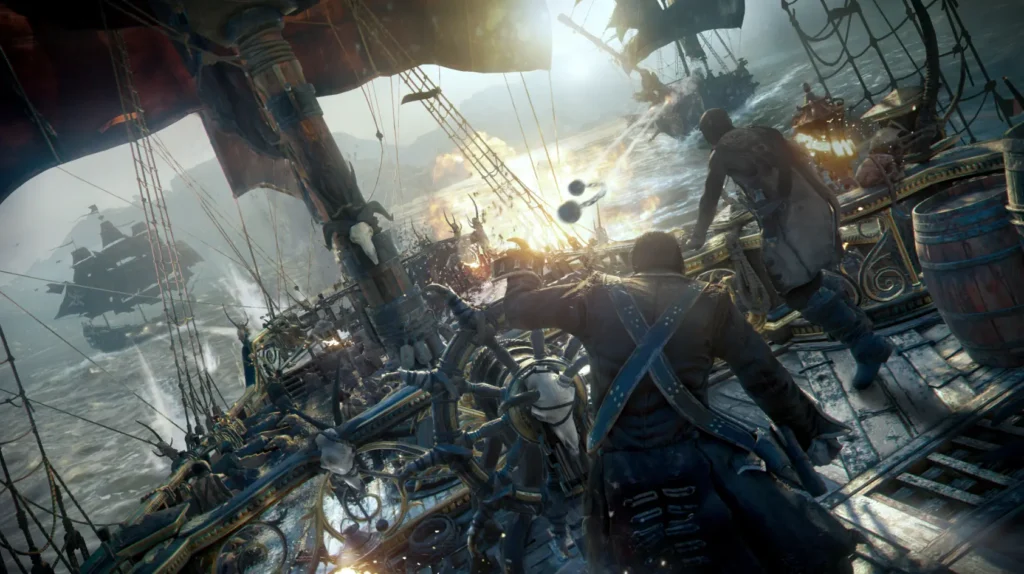
Overall, even with 30 hours of gameplay under your belt, it’s still exciting to spot an enemy of equal level (or higher) with the spyglass, and then launch the assault… This is undoubtedly where the combination of a beautiful soundtrack, strong technology, and dynamic camera angles proves most enjoyable. In short, the naval battles – the heart of Skull and Bones – are a true success. It’s even more addictive in PvP, but note that the player-versus-player mode only gains momentum after the endgame ( estimate 20-25h to complete).
A Small Technical Point:
Let’s drop anchor for a moment to salute the technical quality of Skull and Bones, which uses Ubisoft’s in-house Anvil engine (the one used in Assassin’s Creed). In Quality mode, on PS5, it’s pretty impressive… With the exception of some NPC faces, the seven seas of the Indian Ocean benefit from a detailed production, with beautiful lighting effects, convincing waves and even an artistic direction that deserves respect (Saint-Anne, almost all the outposts). Overall, the world of Skull and Bones is truly appealing. In Quality mode, you get 30 FPS, with a few drops if you draw a weapon in the middle of a storm. Performance mode offers 60 fps, but with less impressive visuals.
We’d also like to take this opportunity to point out that, even as you, the pirate, you can’t just open fire on any shanty with an alias. At launch, when you’re sailing Ubisoft’s seas, there’s no PvP status to activate or deactivate. This mode is currently restricted to world events – which appear regularly on the map (more on this later). On the contrary, Skull and Bones is more about open friendship! During our long hours at sea, we were often joined by other sailors in the flesh when attacking a boss, or emptying a town’s treasury… It seems a bit contradictory for a pirate game, but it does help us get out of complicated situations.
At the Bottom of the Wave

With hindsight, we regret the almost total absence of PvP at the start of the adventure, which would have boosted progression to the “Kingpin” rank. The numerous contracts make the Skull and Bones adventure quite repetitive. You always have to go from point A to point B to smash ships, gather resources, or attack a point of interest (which was sometimes made worse by spawn problems, where objectives and items to pick up didn’t appear in the right place). Fortunately, the ambiance of the seven seas, the naval battles and the “world events” along the way keep things fresh. But overall, it lacks a certain sense of mystery… There were rarely enough subplots to really push us out of our routine – even if Ubisoft did make an effort in this area.
Skull and Bones struggles to tickle our imaginations, simply because it quickly shows its limitations in this area. Take treasure maps, for example. You have to be observant to find the island marked on the map – but as soon as you put your toe on the right stone, you get the text message “a chest is hiding here”. It’s frankly hard to understand this choice, because once you know for sure that the loot is nearby, well, the mystery vanishes immediately.
It’s a bit the same with outposts… After a few stops, you know for sure that you’re going to stumble across the same interactions, namely a campfire dedicated to cooking, a source of clear water, a merchant, and some documents to read. You’ll never find a “temple” with a series of riddles and a chest at the end – or a crazy NPC who tells you an exciting rumor. It’s a little heartbreaking, considering that the mood of the outposts is really good all the time.
Power Is Everything

In the end, it’s not the taste for mystery that will keep you going in Skull and Bones, but rather the taste for gunpowder. Yes, it’s all about improving your ship to keep you moving forward. And here, Ubisoft has done a fine job. For this launch, the title offers 9 rafts divided into 3 classes (DPS, Tank, Support) as well as 9 different weapon types. Each weapon has its own unique gameplay. These include Torpedoes, which are powerful and require you to anticipate your opponent’s path, Long Cannons, which are handy for sniping at a weak point but take a long time to reload, and Mortars, for dropping a fatal shell on the enemy. We enjoyed navigating between these options and finding our own balance, and with three players in co-op, it’s entirely possible to develop a complementary fleet.
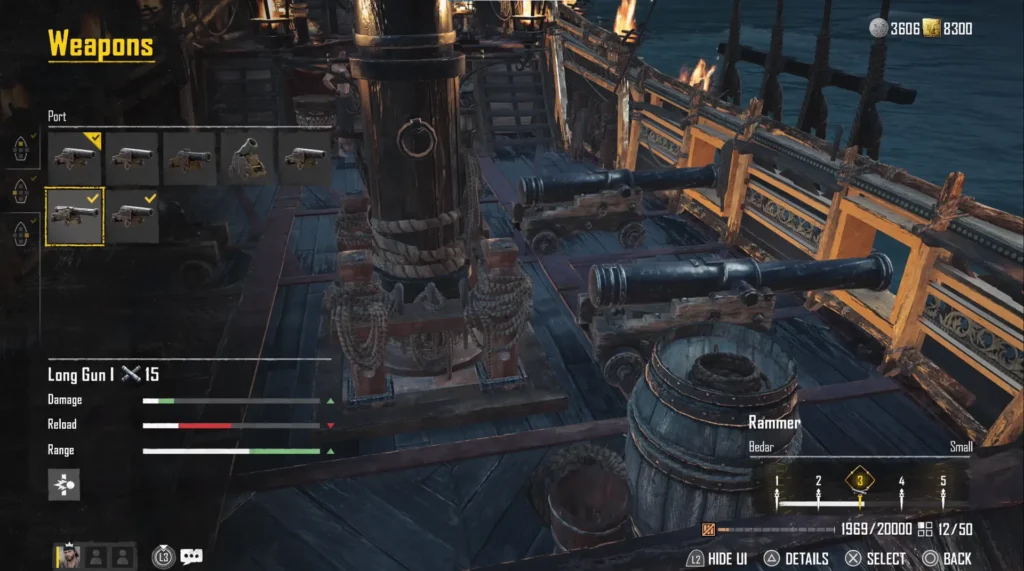
The only downside is that it takes time and hard work to build stronger weapons and ships. While some quests offer interesting pieces of equipment, the rest of the time, you need three things: the right level of experience, the right schematic for the item you’re interested in, and the right resources to build it. Getting the right schematic and the right resources often means going back and forth or spending a fortune on fast travel. Once or twice is fine, but when you repeat the operation for lots of items, it becomes a bit much (the recipes pinned in our quest diary often vanished without warning, which didn’t help). Even so, it’s always satisfying to set sail with a brand-new ship. Fortunately, there are several ways to obtain resources. You can either buy them, harvest them by hand, or steal them by force.
Becoming the Greatest Pirate Ever
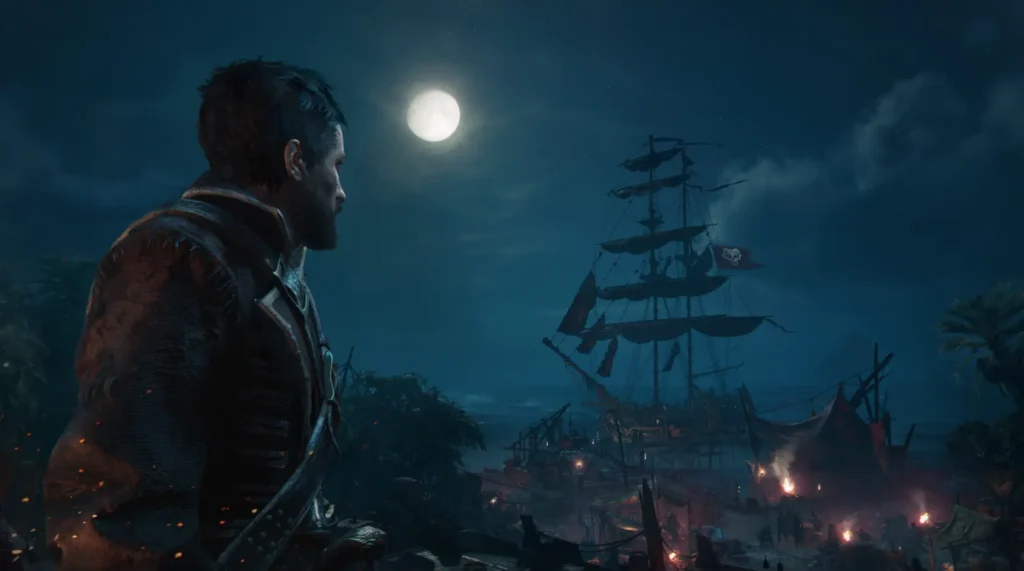
This pursuit of power will serve you well in the endgame, where you’ll have to confront other pirates. But before you are crowned Kingpin, let’s talk about the multiplayer in general! Alongside a somewhat disappointing co-op mode – which only reveals its potential when several players of equal level tackle a common challenge – Ubisoft’s service game is governed by world events that regularly appear on the map.
Before the endgame, there are three of them: the first push sea wolves to collaborate in order to sink a boss, the second involves stealing a well-guarded cargo, and then the Cutthroat Cargo Hunt, a PvP event in which players must retrieve a treasure map and return it to an island. Not much to say on the subject, it’s classic and fairly enjoyable to do, even if we didn’t encounter much resistance in Cutthroat Cargo Hunt. Note that completing two side quests will also enable you to battle a sea monster and a ghost ship.
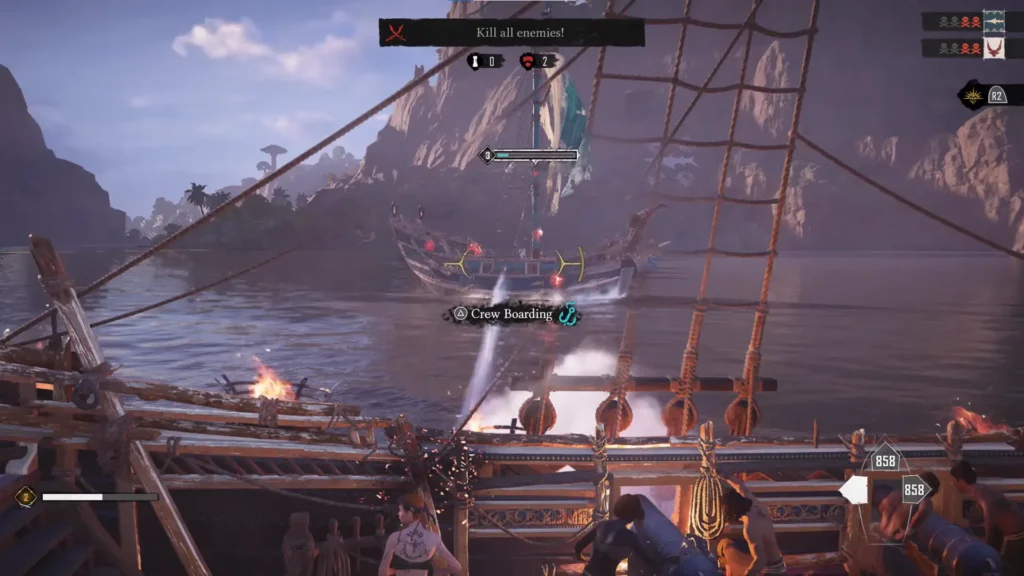
But the real multiplayer action is definitely the endgame. Skull and Bones’ endgame offers you the chance to manage your own trading empire via “The Helm”, a smuggling system that you unlock from level 5. Basically, it’s just a matter of buying raw materials, turning them into rum | opium and then delivering them, but as Kingpin, you can take control of points of interest on the map to create wealth without lifting a finger… The interesting thing is that control of these points of interest involves PvPvE phases (real players, AI ships, and all that good stuff getting in each other’s faces). Victory goes to the player who does the most damage. So it’s not always easy to achieve your goals, and it encourages you to improve your ship to the max.
But that’s not the end of the story, because once a point of interest belongs to you and is ready to fill your pockets, you still have to go and collect that loot! In this case, you’re the one who has to do it – but it’s also a time when PvP is activated, and other players can come and sink you and steal your gold. The idea, then, is to carefully choose your points of interest and plot the safest, most profitable trade route possible. It’s at this point that cooperation with two other friends, who can escort you, can become crucial… Eventually, you’ll collect a special currency to buy legendary items. In short, the endgame concept is very engaging, and we really felt we were discovering Skull and Bones from a new perspective. Perhaps it’s just a shame to have to invest 20-25 hours to get there, but it’s worth it.
Conclusion
Skull and Bones may not be the ultimate pirate game, but it’s a decent naval battle game that will make you want to invest in it. No, there are no third-person action phases here: the adventure takes place almost exclusively on the water, and once the surprise effect wears off, the qualities of Ubisoft’s service game are revealed. The seven seas of the Indian Ocean are both attractive and well-designed, and combat on the open seas is a real success. So, you may struggle to get to the endgame, due to a rather redundant progression, but there’s no denying that the prize is definitely worth the effort. Overall, it’s a pleasant surprise, far from the shipwreck some were expecting.
